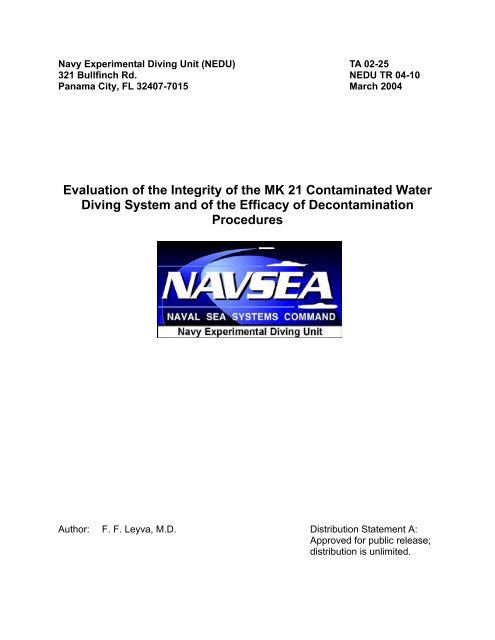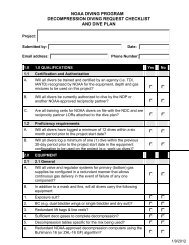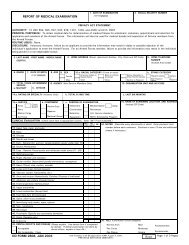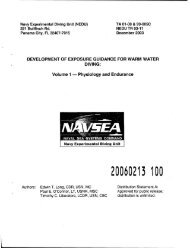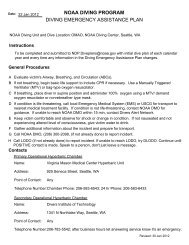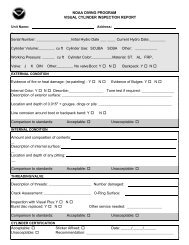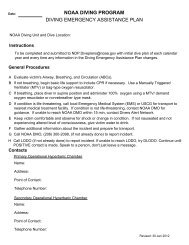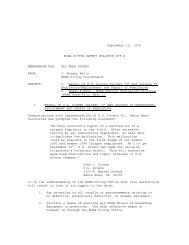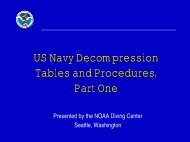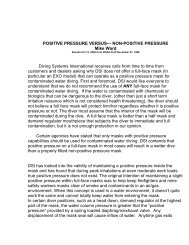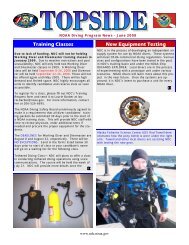Navy Experimental Diving Unit - NOAA Dive Management System
Navy Experimental Diving Unit - NOAA Dive Management System
Navy Experimental Diving Unit - NOAA Dive Management System
You also want an ePaper? Increase the reach of your titles
YUMPU automatically turns print PDFs into web optimized ePapers that Google loves.
CONTENTSPage No.DD Form 1473.............................................................................. iAcknowledgments ........................................................................ iiContents....................................................................................... iiiIntroduction .................................................................................. 1Methods ....................................................................................... 3Results ......................................................................................... 6Discussion.................................................................................... 8Conclusions..................................................................................13Recommendations .......................................................................14References...................................................................................16Appendix:Table 1 .........................................................................................A-1Table 2 .........................................................................................A-3iii
INTRODUCTIONWhether in war or routine peacetime operations, U.S. <strong>Navy</strong> divers are frequentlyrequired to dive in contaminated waters, where hazards may range fromrelatively benign petroleum products to a worst-case exposure to chemical,biological, or radiological agents. Since the potential for encounteringcontaminated environments is increasing, the <strong>Navy</strong> <strong>Experimental</strong> <strong>Diving</strong> <strong>Unit</strong>(NEDU) was tasked with developing a technical manual that providescomprehensive recommendations for planning diving missions in contaminatedwater.That manual (currently in draft form) includes guidance for conducting watertests, characterizing risks, choosing protective equipment, coordinatingdecontamination, and designing training guidelines. Current recommendations inthe U.S. <strong>Navy</strong> <strong>Diving</strong> Manual and the draft technical manual sequester the diverfrom contaminated water environments via a MK 21 underwater breathingapparatus (UBA) mated to a vulcanized rubber dry suit. 1,2 However, no full-scaletesting of the integrity of the recommended contaminated water diving system(CWDS), has been conducted. A manned evaluation of several vulcanizedrubber dry suits was conducted at NEDU in 1993; however, that study tested theintegrity of neither the suits nor the full CWDS. 3 Developing a qualitative testingmethod and performing full-immersion testing has therefore been needed tovalidate the effectiveness of current as well as any future candidate equipment.For diving in contaminated water, protective gear on the Approved for <strong>Navy</strong> Use(ANU) list includes a MK 21 helmet with a double exhaust valve installed toprevent intrusion of water into the helmet, which is mated to a vulcanized rubberdry suit via a watertight seal. Rubber gloves and boots (if not alreadyincorporated into the dry suit) are also mated to the dry suit. But thisconfiguration presents several potential problems.First and most important are anecdotal reports that the MK 21 helmet with adouble exhaust valve is prone to leaking. Informal conversations withexperienced <strong>Navy</strong> and civilian commercial divers reveal little trust in this UBA’sability to protect divers operating in a contaminated environment, particularly atdepths greater than 30 feet of seawater (fsw). When unmanned evaluation ofthis MK 21 configuration was conducted at NEDU in 1993, results suggested thatthe system adequately prevents intrusion of water as long as the peak inhalationpressure is not less than –6 kPa and respiratory minute volume (RMV) does notexceed about 60 liters per minute (L/min). 3 However, the study did not includeany manned testing, nor were the helmets tested in positions other than upright— whereas a working diver may experience a variety of attitudes during a dive.The disparity between actual diver experiences and unmanned testing resultsemphasizes the need for human divers to objectively test the MK 21 with doubleexhaust system.1
Another concern for <strong>Navy</strong> diving is that use of the MK 21 for diving incontaminated water is rapidly declining among commercial diving companies. Infact, few commercial divers recommend its use. Rather, commercial divers areincreasingly using positive pressure rigs for such dangerous diving operations.The MK 21 is a “negative pressure” UBA: its inspiratory demand regulatorcreates negative pressure on the inside of the helmet relative to ambientpressure and thus creates a natural tendency for water intrusion. A positivepressure rig does the opposite: the constant flow of air into such a helmet createsgreater pressure inside the helmet than that outside it, and thus discourageswater entry.The advantage to a positive-pressure system is clear; however, the disadvantageis that it may require an unlimited gas supply. Because of this requirement, sucha system may not be practical for the <strong>Navy</strong>’s operational needs. One solution thathas been suggested for the MK 21 UBA is to adjust the dial-a-breath knob tomaintain a slight, constant flow. This procedure is thought to create a slightpositive pressure and decrease the pressure differential across the exhaustvalve, but it has not been validated.A final concern is that currently recommended procedures for decontaminatingdivers, diving gear, and dive stations have not been rigorously tested for <strong>Navy</strong>operational needs. Derived from standard decontamination techniques found ingeneral texts on chemical, biological, and radiological threats as well as frommethods used by commercial diving specialists, 5–11 decontamination proceduresrecommended in the draft technical manual have not been evaluated. While therecommended techniques have been tested in field settings, they have not beentested on <strong>Navy</strong> dive stations. Since land-based settings and commercial divingoperations are different milieux from naval field settings and operations, suchtesting is needed to ensure that currently recommended procedures can beimplemented during <strong>Navy</strong> diving operations.Of particular concern are possible situations in which surface decompression(SUR D) diving may be needed in a contaminated environment. Because of thefive-minute time limit required to bring divers up from 40 fsw, undress them, andplace them in the chamber for recompression, 9 present decontaminationprocedures may be impractical. Furthermore, the potential for secondarycontamination and decontamination of dive station support equipment needs tobe evaluated thoroughly: <strong>Navy</strong> dive stations tend to be much smaller than fieldspaces or civilian diving platforms.The purpose of conducting immersion tests under this study was therefore toevaluate the integrity of the MK 21 CWDS and the efficacy of decontaminationprocedures. Although the decontamination procedures were considered to beimportant, we did not seek to thoroughly evaluate their effectiveness in relation tothe tenders, dive station, and external diving equipment. The study also2
established a qualitative method for testing the efficacy of contaminated waterdiving equipment.METHODSGENERALTesting of the recommended protective gear was conducted in two phases atNEDU. In each phase, U.S. <strong>Navy</strong> divers were submerged in a 3,600-gallon,stand-alone tank (“ark”) approximately 10 feet deep and large enough toaccommodate three divers at a time. Performed in September 2003, Phase 1was designed to test the general integrity of the system and the preliminaryefficacy of decontamination procedures by conducting full immersion at thesurface (depth 10 fsw in NEDU’s OceanSimulation Facility (OSF).EQUIPMENTIn Phase 1, divers were dressed in the full CWDS, including gloves. The Naval<strong>Diving</strong> and Salvage Training Center (NDSTC), loaned six rarely-used Viking HDvulcanized rubber dry suits to NEDU. These suits were used in all diving. ThreeMK 21 UBAs, each with new double exhaust valves installed on them, were alsoused throughout the diving. The U.S. <strong>Navy</strong> MK 3 surface supply diving systemprovided air to the divers.In Phase 2, divers were dressed in newly purchased Amron AHD1600vulcanized rubber dry suits, three of which were used for all diving. The samethree MK 21 UBAs with double exhaust valves that had been used in Phase 1were also used in Phase 2. Unlike Phase 1 divers, those in Phase 2 did not weargloves mated to the dry suit. <strong>Dive</strong>rs used surface supplied air from the OSF airbanks.Phase 1Tests of CWDS integrity and decontamination procedures were conducted on thesame dives. For this phase, the ark was placed in the OSF high bay. Wearingonly shorts underneath the dry suit, fully outfitted divers submerged themselvesin the ark, which was initially filled only with water.Once they were on the bottom of the ark (maximum depth, 5 fsw), they wereinstructed to simulate working conditions by performing a series of physicalmaneuvers that placed strain on potential leak points (e.g., neck and wrist seals)in the configuration. These maneuvers included abduction and adduction of thearms and legs, as well as flexion and extension of the neck, shoulders, elbows,3
After all divers had completed the designated maneuvers, the OSF wasdecompressed to the surface. Before exiting the facility, divers were hosed downwith water to remove exterior fluorescein while they stood on the ladder abovethe ark. Each diver then exited the OSF, and his gear was removed.Immediately after the helmet was removed, a black fluorescent lamp was used toexamine both the helmet’s interior and the diver’s head and neck for traces offluorescein. Any traces of the chemical and its locations were noted but notquantified. Any helmet found to have fluorescein in it was washed thoroughly,until no signs of the chemical could be found. As in Phase 1, all dive gear wasreused. Before being reused, each helmet was dried with cotton gauze to removeany remaining water.Factors other than depth and position were also manipulated during this phase.We performed some dives with the MK 21 dial-a-breath open slightly (so that thediver could hear a quiet flow of air), some with the steady flow valve open tocreate a slight positive pressure inside the helmet, and some with both the dial-abreathand steady flows open. These factors were adjusted both before andduring selected dives. Results from specific manipulations of these factors areshown in Appendix A, Table 1. Furthermore, after the first three dive sets, diverswere instructed to perform an initial prolonged ventilation and purge procedure topurge the helmet of any residual water that the cleaning conducted betweendives may have left in it.Before the first day of diving, all equipment was maintained and serviced perU.S. <strong>Navy</strong> regulations. However, after the first day’s dives, all the MK 21 helmetswere disassembled, and each demand regulator assembly was sealed withsilicon, as the manufacturer advised. The current <strong>Navy</strong> U.S. <strong>Navy</strong> MK 21maintenance manual does not specify that silicon sealant be used for thispurpose. 14RESULTSPhase 1Fourteen diver-subjects performed a total of 14 dives followed bydecontamination over 2 days. Two dives were performed without fluorescein inthe water; 12, with the chemical. The water temperature for both diving days was80 °F, and air temperatures ranged from 78 to 85 °F. Of note, no diverexperienced an adverse reaction to fluorescein during in any part of the study(including both phases 1 and 2).Bottom times ranged from 5 to 8 minutes, with an average of 5.8 minutes. Thetimes divers needed to complete decontamination (from exiting the water tocompletely removing the protective gear) ranged from 2 to 10 minutes, with an6
average time of 7.1 minutes. (This average is based on 13 dives, as an errorprevented one diver’s decontamination time from being recorded.)On the bottom, two divers reported that they believed their dry suits were leaking.After being decontaminated, however, neither of these divers had traces offluorescein on his body — although one had a clear liquid on his left foot. Nodiver on the bottom reported a helmet leak.Seven of the 14 divers were found to have residual traces of fluorescein on theirbodies after decontamination was completed: three divers had the chemical onlyon the head; one had it on both his neck and upper extremities; one had it onlyon his upper and lower extremities; and one had it only on his lower extremities.During post-decontamination inspection of gear, there were three incidents offluorescein located inside the helmet (faceplate, oral-nasal mask, and hood).None of the divers in these cases had reported any sensation of leakage into hishelmet during his dive. Two of the divers who had residual fluorescein on eitherthe head or neck also had traces of fluorescein in their helmets. Two dry suitswere also noted to have leakage of several drops of fluorescein around the dumpvalve located on the left arm. Of the divers who wore these two suits onoccasions when the leaks were found, one had fluorescein on his left upper arm,and the other had traces of the chemical on his left lower leg. The remaining twodivers who had post-decontamination traces of fluorescein on their bodies had novisible leaks inside either their suits or helmets.Phase 2Twenty U.S. <strong>Navy</strong> divers performed 22 dives in eight manned sets in the OSFduring two days in December 2003. <strong>Dive</strong> depths ranged from 5 to 60 fsw (0 to 55fsw on the OSF digigauge), and bottom times ranged from 9 to 14 minutes, withan average of 11.7 minutes. Since two dive sets (two divers each) wereperformed in the ark with the OSF not pressurized, the maximum depth for thosedives was 5 fsw. Only two divers were used for each of these sets, since onehelmet was pulled from the study for the day to examine it for worn parts. Thehelmet was subsequently returned for use on Day 2. Water temperature for bothdiving days ranged from 66 to 67 °F.Regardless of depth, all divers reported water leakage into the helmet via theoral-nasal mask when both the dial-a-breath and the steady flow valve wereclosed. These reports occurred both on the surface and at depth when diverhead positions were changed from upright. Throughout the entire study, no diverreported leakage into the helmet while he was in the upright position. <strong>Dive</strong>rsdescribed leaks varying from a slight “trickle” onto the face to a “spraying” ofwater during deep inspiration. Eight divers reported leakage only while they werein the supine position; 1, only in the prone position; 1, only in the invertedposition. Twelve experienced leakage while they were in more than one position.7
When dives were performed with the dial-a-breath slightly opened and the steadyflow valve off, results were similar. Three divers (set 6) attempted thisconfiguration. Initially on the surface, the divers kept the dial-a-breath off, andtwo of them reported leaks in the supine, inverted, and prone positions. After anexaggerated ventilation and purge, the divers were taken to 60 fsw, where theyopened the dial-a-breath. All three divers reported leakage in at least two of thethree positions tested. During postdive inspection, the helmets of all three diversin this set had fluorescein in the oral-nasal mask.Two dive sets (six divers in sets 7 and 8) were performed with both the dial-abreathand the steady flow open. The maximum depth of one set was 60 fsw;that of the other was 40 fsw. Only one of the six divers reported leakage into thehelmet while he was on the surface in the inverted position. He also experiencedleakage while he was on the bottom. One diver reported no leaking in anyposition while he was on the surface and at depth. Four divers in these two setsreported leaks only at depth (two divers at 40 fsw and two at 60 fsw): two hadleaks while they were in the supine position, one while he was in the proneposition, and one while he was inverted. After performing their maneuvers, five ofthe divers in these sets turned off their steady flows and repeated the positions.All subsequently experienced leakage in at least one position. Two of the diversturned off the dial-a-breath but left the steady flow open and repeated theirmaneuvers at depth. With this configuration, both of these divers reportedleakage. All helmets for divers in sets 7 and 8 were found to have residualfluorescein in the oral-nasal masks.One dive (set 5; two divers) was performed with only the steady flow valvesopen. <strong>Dive</strong>rs in this set performed the maneuvers only at the surface (5 fsw).Both divers reported leakage into the helmet when they were in the supineposition. However, only one of these diver helmets contained fluorescein duringpostdive inspection.Results of postdive helmet inspections showed all but one helmet to havefluorescein in the oral-nasal mask (Appendix A, Table 2; this exception was froma dive performed at 5 fsw with the steady flow open throughout). Thirteen diverswere found to have residual fluorescein on their faces. All of these divers hadfluorescein in one or more of the following areas: chin, nose, cheeks, or perioralregion. Two divers each had residual fluorescein on one ear.DISCUSSIONPhase 1Overall, the MK 21 CWDS performed well in this phase of testing. Despite usingrather old and worn dry suits, only two divers reported feeling leakage into theirsuits during the dives, and these divers were found to have no residualfluorescein on their bodies or in the suits they used. Both of these divers also8
eported feeling very hot before and during diving, a feeling that is to be expectedbecause of the relatively hot air temperatures during the study. Both divers arelikely to have mistaken sweat for water intrusion. In fact, one of these divers (whohad reported leakage around his right leg) was found to have a clear liquid (notfluorescein) on his right foot during postdive inspection.Of the seven divers found to have residual fluorescein on their bodies duringpostdive inspection, none had reported feeling leakage during their dives. In onlyfour of these cases, the location of the fluorescein discovered seemed consistentwith the location of the leak: two with leaks around the suit’s exhaust valve, andtwo with helmet leaks. For the remaining three “contaminated” divers, no visiblesigns of fluorescein were found in either the suit or the helmet. It is difficult todetermine whether they were exposed to fluorescein by a breech into the suit orhelmet or whether they were “contaminated” by some other event during thestudy (e.g., secondary contamination from the decontamination and undressprocedure).During diving it seemed unlikely that divers could have fluorescein inside theirhelmets, hoods, or suits without feeling an intrusion of the cooler (80 °F) water.Additional observation revealed that the dive station (where divers dressed) waslocated below the ark’s access platform, and on several occasions divers causedsufficient splashing upon entering the water that the fluorescein-containing watermight contaminate the dive station just before the next diver was dressed. Thissplashed water might have contaminated the helmets and divers before theyentered the water. Fortunately, the splashing problem was observed early, anddivers were instructed to make a more gentle entry.However, even after this problem was corrected, at least one diver had residualfluorescein inside his helmet and on his body (head and hands). This diver andseveral others had served as dive tenders before making their dives, and so theymight have been contaminated before making their dives. The inability todefinitively determine when an exposure to fluorescein occurred may represent aflaw in the study design. It would have been useful to undress and examinesome divers without having them undergo decontamination.Two potentially significant problems were found with the suits. First, since thesuits were old and had been poorly maintained, the rubber parts were stiff orcracking and easily torn. At least three of the suits were damaged during diverdressing or undressing: in two incidents the neck seals were torn when suitswere removed during decontamination. This problem of equipment condition is alikely difficulty in the fleet, since dry suits are not frequently used. Therefore, ifsuch suits are needed, the ones available for a particular operational unit mayalso be old, worn, and easily damaged — if they are not frequently and properlymaintained.9
The second problem discovered with the dry suits was that of leakage throughthe exhaust valve. Although only two of the suits leaked around this valve, both ofthem were used multiple times during the study, and each leaked only once.These two incidents, however, constituted 17 percent of the dives performed withfluorescein in the water. This exhaust-valve leakage is not surprising, since drysuit manufacturers report that any valve on a dry suit is a potential source ofwater intrusion and that the number of valves on dry suits should be minimizedwhen maximal protection is to be used. 8The decontamination procedures seemed effective in removing the fluorescein.This is not surprising, since the dye is water-soluble. The greatest amount waswashed away during the high-pressure rinse in the first zone of decontamination.However, this procedural step would not likely be as successful in removing moreviscous or lipid-soluble chemicals (e.g., petroleum products) and additionaltesting using a lipid-soluble contaminant analog, some added solids, and someadhesive contaminants is needed to support increasingly definitive conclusionsabout the efficacy of the recommended decontamination procedures.Nevertheless, fully performing these current procedures provided much usefulinformation. One major problem identified was that divers might becomecontaminated by contact with tenders during removal of the suits. Removing adry suit even in an uncontaminated setting is difficult and requires cooperationbetween the diver and tenders. In a contaminated environment, members of adecontamination team may have residual contamination on their protective suits,and these residuals can get on the diver while the neck seal and arms are beingremoved. Experienced divers also tend to try to remove the suits themselves,and this tendency increases their chances of becoming contaminated. During thestudy we had to continually remind divers to let the decontamination team domost of the work.The average time needed for decontamination was more than 7 minutes. Whilethis seems relatively fast, it is too slow to be used in SUR D diving, especiallysince this time does not include individual showering, the final step ofdecontamination. Furthermore, if a contaminant is more difficult to remove thanthe water-soluble fluorescein, the time required for decontamination is also likelyto be longer than it was in this study.Another potential concern is the high-pressure wash the diver receivesimmediately upon exiting the water. We found that the spray produced by thiswash can easily spread to other areas of the dive and decontamination stations.Even if a diver is being rinsed on a boat ladder before he comes aboard, thepotential for secondary contamination from the spray is great, especially in windyor rough conditions. This potential for secondary contamination is significant,because most diving vessels have a relatively small amount of space to set up adive station and an area for decontamination. Droplets produced from the spraycould also contaminate ventilation or gas intake structures.10
Other questions about the efficacy of decontamination procedures include whatprotective gear is best for tenders and members of a decontamination team andhow might the dive station, umbilical hoses, and decontamination teams be bestcleaned. In this study we did not attempt to thoroughly evaluate suchdecontamination questions. More work is needed to ensure that therecommended procedures fit into <strong>Navy</strong> operational scenarios.Phase 2The MK 21 helmet with double exhaust valve fails to prevent intrusion of water,unless the helmet is in the upright position. We are confident in concluding thatthis helmet configuration fails: all divers reported leakage from spraying ortrickling of water on their faces, and fluorescein was found in the oral-nasalmasks inside all but one helmet after they were removed. This conclusion isparticularly concerning, since the greatest amount of leakage (from spraying ofwater) occurred when divers took deep breaths, as they are likely to do duringworking dives.The only configuration that excluded water from the rig was with the steady flowvalve open in less than 10 fsw. At all depths tested below 10 fsw, no manipulationof the helmet (e.g., via the steady flow valve or the dial-a-breath) consistentlyprevented water intrusion if the helmet position was changed from upright.Although most commercial diving experts have recommended full positivepressure rigs for any contaminated water diving and opening the steady flowvalve created additional positive pressure in the helmet, our finding is contrary toconclusions drawn from NEDU unmanned testing — test conclusions suggestingthat simply opening the demand regulator’s dial-a-breath to a slight free-flowcould sufficiently reduce the pressure differential across the regulator andprevent leakage. In this study, adjusting the dial-a-breath did not prevent waterintrusion.Despite anecdotal reports that the MK 21 with double exhaust valve leaks, wewere somewhat surprised in that all of the helmets leaked on the first day ofdiving. The technician responsible for helmet maintenance thought, duringinspection after the first three dive sets, that one of the helmets had a wornregulator seal, so that helmet was removed for possible maintenance. Neither ofthe other two helmets was believed to have similar problems.After the first day’s diving, all of the helmets were taken apart and inspected, butnone showed definitive signs of wear or malfunction. A representative from KirbyMorgan, Inc., the manufacturer of the helmet, suggested using a silicon seal forthe regulator assembly. This adaptation was added, although the <strong>Navy</strong>’s currentmaintenance manual for the MK 21 does not include this procedure. Despitesuch extra maintenance, however, on the following day the helmets did notperform better than they had performed the day before. Since the manufacturer’srepresentative indicated that the Kirby Morgan testing of the helmet assembly11
had not included changing the helmet’s position, his information suggests that themanufacturer may not have been aware of the leakage problem.The results are alarming for several reasons. Most important is a concern that thecurrently recommended CWDS cannot fully protect divers. Although we wereunable to exclude water from the helmet, we may have found a way to reducethe amount of leakage. <strong>Dive</strong>rs who had the steady flow valve open to create aslight positive pressure tended to report feeling “drops,” rather than a spray, ontheir faces, while divers without the steady flow valve open almost alwaysreported feeling significant spraying. The disadvantages to leaving the steadyflow open throughout a dive are that it may interfere with diver communications,may create a noise hazard, and, by using additional gas, may create a problem ifthe diver’s gas supply is limited.Since we did not quantify the amount of leakage into the helmet during dives orthe amount of residual fluorescein in the oral nasal mask, we cannot offerconclusions about how leaving the steady flow open may decrease the intrusionof water. It may have been useful to somehow configure the MK 21 toquantitatively measure water backflow across the double exhaust valve, but sucha method and such materials were unavailable for the purposes of this study.Furthermore, knowledge of exact amounts of water intrusion may not be useful ifthe purpose of protective gear is to completely sequester a diver from theenvironment and we have effectively demonstrated that such gear does not.One might argue that for some contaminated water scenarios, a small amount ofleakage (e.g., minor oil spills) may be acceptable. However, in other scenarios(e.g., those involving chemical, biological, or radiological warfare agents), anyamount of leakage is unacceptable.Since both unmanned testing and the present study find no leakage into the rigwhen the head is kept in the upright position, a possible solution is to restrictdiver movement while wearing the CWDS. This may be unreasonable dependingon operational needs, but this resolution could be employed short term until morefeasible solutions (involving equipment or procedures) are identified.It should be noted that this study used only three MK 21 helmets with doubleexhaust valves installed. The double exhaust valves were new, but the helmetswere not. (The helmets, however, had been maintained properly per U.S. <strong>Navy</strong>standards and were in excellent working condition.) Despite the small sample ofequipment tested, this sample is likely to accurately represent what might befound in the fleet, where the supply of this expensive, cumbersome gear is verylimited.12
CONCLUSIONSMK 21 CWDSWe found some aspects of the MK 21 to perform well, while others hadshortcomings. Most important, this study validates anecdotal reports andcommercial industry recommendations by revealing that the double exhaustconfiguration on the MK 21 helmet fails to exclude water. While it may bepossible to minimize water entry by opening the steady flow valve, we wereunable to consistently prevent leakage. And in many diving scenarios, anyamount of exposure of contaminants to a diver is unacceptable.The industry standard is a positive pressure rig such as the Air Hat (DESCOCorporation; Milwaukee, WI). However, these rigs are expensive and requirefree-flow capabilities that may not be available on dive stations with limited gassupplies. Another possibility is to use a “return-line exhaust” configuration suchas the Ultrajewel II “Dirty Harry” system (<strong>Dive</strong>x Ltd.; Aberdeen, Scotland, U.K.)with the MK 21. The <strong>Dive</strong>x is a closed-circuit breathing system that returns adiver’s exhausted gas to the surface via a separate exhaust hose. Since thissystem uses the MK 21 helmet, it might be easily incorporated into <strong>Navy</strong> diving.Ultimately, despite the shortcomings revealed in this study, I believe the MK 21with double exhaust valve is the <strong>Navy</strong>’s most protective gear configuration fordiving in contaminated water. Although the MK 20 full face mask and basic scubarigs were not tested, it is unlikely that they can protect the diver againstcontaminant exposure as effectively as the MK 21 can. Therefore, this helmetshould remain the protective gear of choice for <strong>Navy</strong> diving until solutions to itsleakage problems can be identified and implemented.Despite their age and wear, the dry suits provide good protection, although theirexhaust valves are prone to leak. The amount of leakage (2–3 drops) that thisstudy found with these valves, however, was relatively small, and properlymaintaining and testing them before diving may minimize if not eliminatecontamination exposure problems. Furthermore it is ideal to use dry suits withthe smallest possible number of valves or entry points in planning for diveoperations in a contaminated environment. Old suits, even if maintained properly,may still suffer problems involving rubber parts: particularly when stretched, e.g.,the neck seal will naturally age and crack. Special attention should be given toinspecting these rubber parts before, during, and between uses.Decontamination ProceduresIn making a limited evaluation of the currently recommended decontaminationprocedures, this study found them to be effective, overall, at removing a watersolublecontaminant. No conclusions can be drawn on their effectiveness inremoving lipid-soluble substances, adhesive materials, or solids. Despite thesepositive results, certain aspects of decontamination may be potentially13
incompatible with <strong>Navy</strong> operational diving platforms. In particular, the highpressurerinse may not be desirable, since it may exacerbate secondarycontamination. Also, the potential for contaminating a diver during undress isgreat, and care should be taken to prevent the decontamination team fromtouching the diver’s body. Additional work is needed to thoroughly evaluatedecontamination procedures.RECOMMENDATIONS1. The MK 21 with double-exhaust valve should remain the protective gear ofchoice for <strong>Navy</strong> diving until a suitable solution to the leakage problem isidentified and implemented.2. Testing of other helmets or helmet configurations such as the DESCO AirHat or the <strong>Dive</strong>x “Dirty Harry” systems should be considered forcontaminated water situations in which any contact of a contaminant (e.g.,high levels of chemical, biological, or radiological warfare hazards) with adiver’s face is unacceptable because its ingestion or inhalation exposes thediver to extreme risk.3. Further research and testing is warranted to• determine definitive guidelines for what types of contamination qualifyas “acceptable” for some exposure,• further test decontamination procedures with a lipid-soluble oradhesive contaminant analog on actual <strong>Navy</strong> dive stations, and• determine the quantity of water that enters the MK 21 helmet.4. The draft contaminated water diving technical manual should be updated withthe following changes:• The MK 21 CWDS should not be used in any setting when contact of acontaminant (e.g., high levels of chemical, biological, or radiologicalwarfare hazards) with a diver’s face is absolutely unacceptablebecause its ingestion or inhalation presents an extreme risk to thediver.• In situations where exposure to a small amount of contamination maybe acceptable, the MK 21 CWDS should be used with the steady flowvalve open to create a slight positive pressure inside the helmet.<strong>Dive</strong>rs should take special care to avoid assuming a supine, prone, orinverted position.• Wording that helmet leakage is minimal if a diver stays upright shouldbe added.• Leakage in the MK 21 has been demonstrated objectively, althoughdivers might not sense that such leakage is happening, and thisinformation should be added in the section on the MK 21.14
• Any wording stating that leakage of water into the MK 21 can bemitigated by adjusting the dial-a-breath to a slight free-flow once thediver reaches the bottom should be removed.• The high-pressure rinse should be removed from the recommendeddecontamination procedures, and it should be replaced with a highvolume, low-pressure rinse when contaminants are non-adhesive orwater soluble.• To detect signs of wear and tear before, during, and after diving, drysuits should be inspected before, during, and between dives. Thisinspection must include all valves and seals.• No SUR D diving should be attempted in contaminated wateroperations.15
REFERENCES1. Commander, Naval Sea <strong>System</strong>s Command, U.S. <strong>Navy</strong> <strong>Diving</strong> Manual,Revision 4, SS521-AG-PRO-101 (Arlington, VA: NAVSEA, 1999).2. NAVSEA draft, “Contaminated Water <strong>Diving</strong> Technical Manual” (underreview).3. L. J. Crepeau, Contaminated Water <strong>Diving</strong> <strong>System</strong> Evaluation, NEDU TR 12-93, <strong>Navy</strong> <strong>Experimental</strong> <strong>Diving</strong> <strong>Unit</strong>, Dec 1993.4. L. J. Crepeau, Re-evaluating the DSI Contaminated Water <strong>Diving</strong> Kit’s Abilityto Prevent Water Aspiration in the MK 21 MOD 1 UBA, NEDU TR 7-94, <strong>Navy</strong><strong>Experimental</strong> <strong>Diving</strong> <strong>Unit</strong>, Apr 1994.5. F. Perna, CWO3, OIC, MDSU-2, Contaminated Water – USS Cole Recoveryand Salvage Operations Lessons Learned, memorandum to CommandingOfficer, <strong>Navy</strong> <strong>Experimental</strong> <strong>Diving</strong> <strong>Unit</strong>, Jan 2001.6. W. A. Steigleman, Survey of Current Best Practices for <strong>Diving</strong> inContaminated Water, <strong>Navy</strong> <strong>Experimental</strong> <strong>Diving</strong> <strong>Unit</strong>, NEDU TR 02-07, July2002.7. S. M. Barsky, <strong>Diving</strong> in High-Risk Environments, 3rd ed. (Santa Barbara, CA:Hammerhead Press, 1999).8. <strong>Diving</strong> in Contaminated Water, 3rd ed. (Portsmouth, NH: Trelleborg Viking,Inc., 2000).9. Medical <strong>Management</strong> of Chemical Casualties Handbook (Aberdeen ProvingGround, MD: Medical Research Institute of Chemical Defense, 1995).10. Medical <strong>Management</strong> of Biological Casualties Handbook (Fort Detrick, MD:U.S. Army Medical Institute of Infectious Diseases, 1998).11. Medical <strong>Management</strong> of Radiological Casualties Handbook (Bethesda, MD:Military Medical Operations Office, Armed Forces Radiobiology ResearchInstitute, 1999).12. Material Safety Data Sheet — Fluorescein (Piqua, OH: Kingscote Chemicals,1999).13. Aviation-Crew <strong>System</strong>s Rescue and Survival Equipment, NAVAIR 13-1-6.516
14. Commander, Naval Sea <strong>System</strong>s Command, Technical Manual, Operationand Maintenance Manual, Organizational Level, Underwater BreathingApparatus (UBA) MK 21 Mod 1, Revision 4, S6560-AG-OMP-010(Washington, DC: NAVSEA, 2002).17
Table 1.APPENDIX A<strong>Dive</strong>set<strong>Dive</strong>rno.Depth(fsw)BT(min)Dial-abreathopen(Y/N)?SteadyFlowOn (Y/N)?Leak(Y/N)?If leak, whatposition/s?Comments1 1 60 13 N N Y Supine <strong>Dive</strong>r had R ear squeeze duringdescent1 2 60 13 N N Y Supine Possible moisture detected in proneposition122233 60 13 N N Y Prone,supine,inverted4 60 10 N N Y Prone,supine5 60 10 N N Y Prone,supine6 60 10 N N Y Prone,supine7 50 9 N N Y Prone,supine,inverted<strong>Dive</strong>r notes significant “spray” aroundoral-nasal mask.Spray in inverted position<strong>Dive</strong>r reports possible leakage onsurface3 8 50 9 N N Y Supine Helmet examined and thought to havea worn seal — pulled out formaintenance349 50 9 N N Y Supine,Inverted10 5 N N Y Supine,pronePrior to dive, divers performedexaggerated ventilation and purgeA-1
<strong>Dive</strong>set<strong>Dive</strong>rno.Depth(fsw)BT(min)Dial-abreathopen(Y/N)?SteadyFlowOn (Y/N)?Leak(Y/N)?If leak, whatposition/s?Comments4 11 5 N N N Supine,prone5 12 5 N Y Y Supine5 13 5 N Y Y Supine No leak in helmet found post dive6 14 60 12 N (s) N N (s) ProneY (d)Y (d)6 15 60 12 N (s)Y (d)N Y Supine(s and d)6 16 60 12 Y (s and d) N Y All7 17 60 14 Y Y N (s)Y (d)Supine77818 60 14 Y Y Y(s and d)19 60 14 Y Y N(s and d)20 40 12 Y Y N (s)Y (d)Supine andinvertedSupineOn bottom, turned off steady flow andrepeated maneuvers — significantleakSecured dial-a-breath with steady flowon and repeated positions, + leakinvertedSecured steady flow on bottom andrepeated positions, + leak prone8 21 40 12 Y Y N (s) AllY (d)8 22 40 12 Y Y N Steady flow secured and positionsrepeated, + leak prone and inverted.S = surface; D = depthA-2
Table 2.<strong>Dive</strong>Set<strong>Dive</strong>rNumberFluoresceinin Helmetpost dive(Y or N)?If FluoresceinPresent,Location?Fluoresceinon <strong>Dive</strong>r?If on <strong>Dive</strong>r, area?1 1 Y ONM Y Bilateral cheeks, chin1 2 Y ONM N1 3 Y ONM Y Chin, Right cheek2 4 Y ONM Y Chin2 5 Y ONM N2 6 Y ONM Y Chin3 7 Y ONM Y Chin, perioral3 8 Y ONM N3 9 Y ONM Y Left cheek4 10 Y ONM N4 11 Y ONM Y Left ear and chin5 12 N N5 13 Y ONM Y Chin6 14 Y ONM N6 15 Y ONM Y Chin, perioral6 16 Y ONM Y Perioral7 17 Y ONM N7 18 Y ONM Y Nose7 19 Y ONM N8 20 Y ONM Y Perioral, chin, ear, neck8 21 Y ONM Y Perioral, chin, nose8 22 Y ONM Y PerioralA-3


